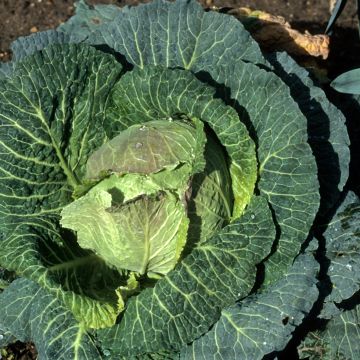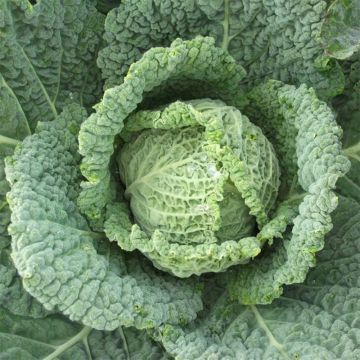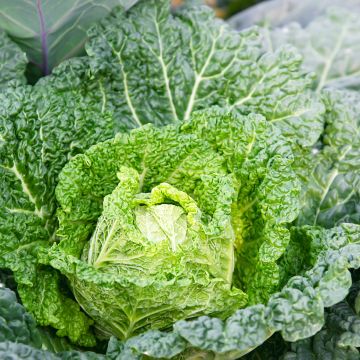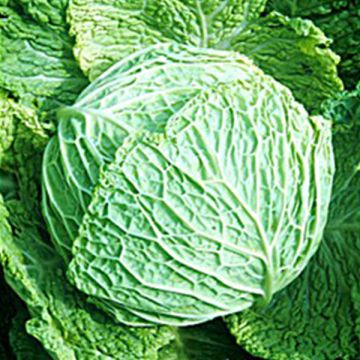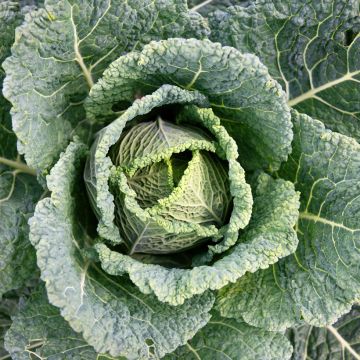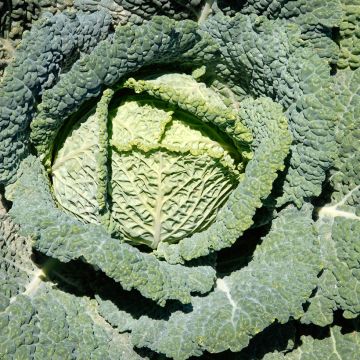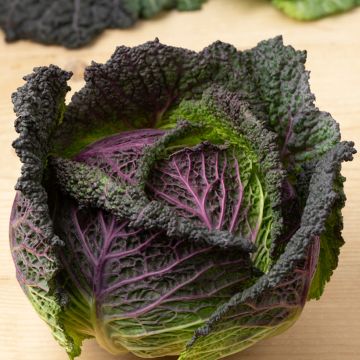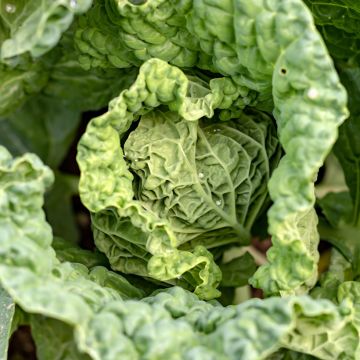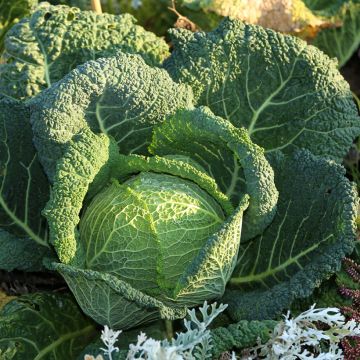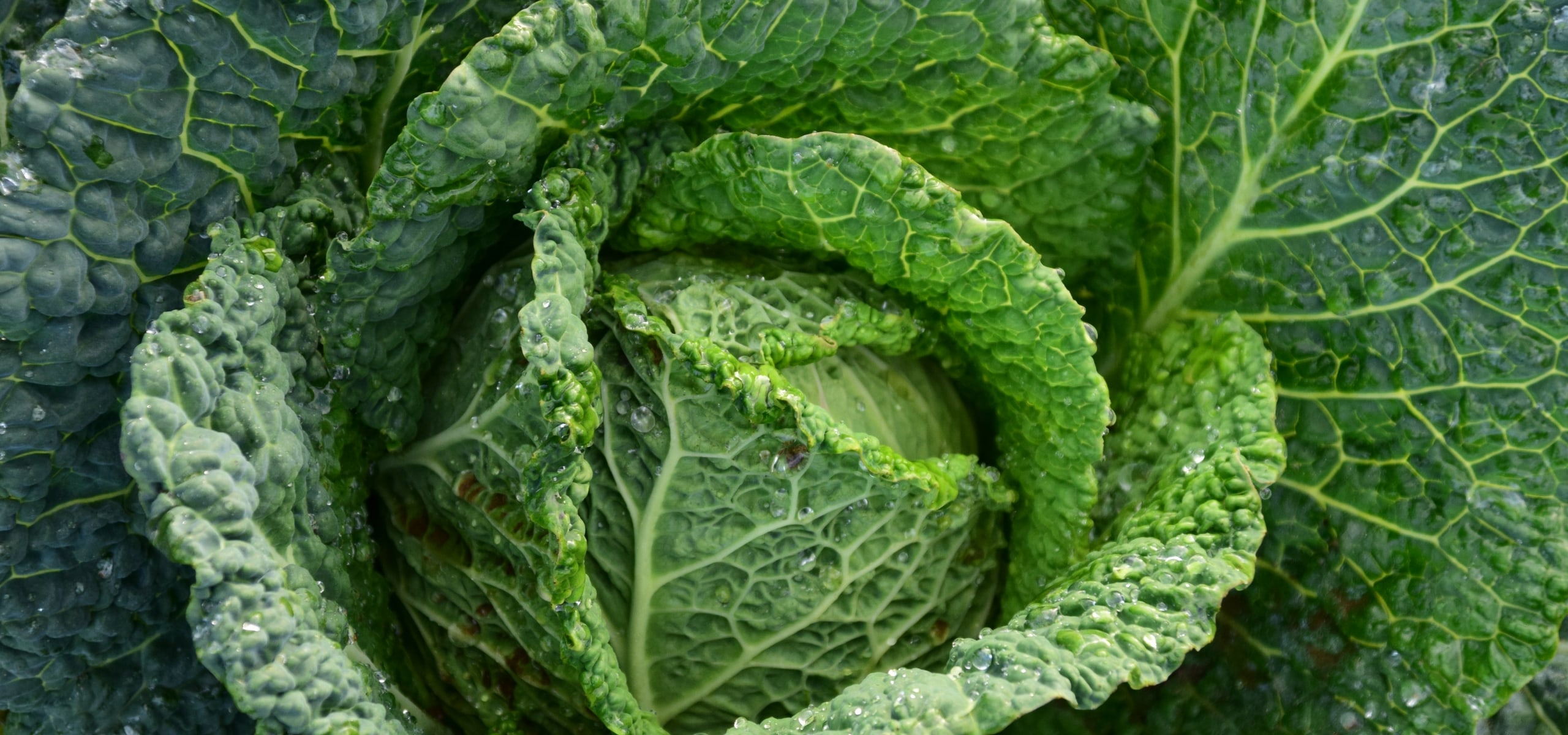
Growing cabbage and Milan cabbage
Tips and tricks for a productive vegetable garden
Contents
The white cabbage and the Milan cabbage are two varieties of vegetables prized for their nutritional richness and versatility in the kitchen. They can be eaten raw, in coleslaw, grated, in soup, stew, braised, stir-fried, fermented, or in sauerkraut. They are treasures of vitamins C, B6, and B9, as well as fibre and minerals. Very hardy, although emblematic of winter, they can be sown and harvested almost all year round. Growing these cabbages in the vegetable garden may seem complicated, but with the right techniques, success is within reach. Discover the essential steps to plant and successfully grow these delicious vegetables while optimising their yield. Enjoy abundant and tasty harvests!
Also, check out our complete guide on cabbage
About cabbage and Milan cabbage
Cabbage (Brassica oleracea) is an herbaceous vegetable plant belonging to the large family of Brassicaceae (formerly known as Cruciferae). Heading cabbage and Milan cabbage are two varieties of cabbages cultivated for their dense and leafy heads, which can be consumed raw or cooked in a multitude of recipes. The Heading cabbage (Brassica oleracea capitata, with capitata in Latin meaning “head”) actually includes Smooth cabbages such as red, white, or green cabbages, and curly-headed cabbages (Brassica oleracea var. sabauda), like the Milan cabbage, which consists of strongly crinkled or frilled leaves.
- The heading cabbage, or smooth cabbage, is characterised by its round and compact head, with smooth and tightly packed leaves against one another. Its large, slightly flattened heads are distinguished by their colour (green, red, or white) and their harvest period (early, mid-season, or late). Heading cabbage is particularly rich in vitamins C and K, fibre, and antioxidants, making it an excellent choice for supporting a balanced diet.
- The Milan cabbage, also known as Savoy cabbage or crinkled cabbage, is recognisable by its large, frilled and crinkled leaves, which are darker and have more pronounced veins than those of heading cabbage. It comes in dark green, blonde green, or features green leaves tinged with purple. It offers a slightly sweeter flavour and a more tender texture, particularly appreciated in stews or soups. This type of cabbage is also an important source of nutrients, providing vitamins A, C, and K, as well as minerals like potassium and magnesium, while being, like all cabbages, low in calories.
Read also
Sowing and pricking out cabbagesHow to sow cabbage and Milan cabbage?
When to Sow?
Direct sowing in place is possible, but preparing or purchasing young plants to be transplanted into the vegetable garden once all risk of frost has passed is the most commonly used method.
Generally, cabbages and Milan cabbage are sown from February (under cover) to June for a harvest from August to December. However, each variety of cabbage corresponds to an ideal sowing period, which can vary in length: this information is found on the seed packet, and it is important to refer to it. Thus, for a harvest of:
- spring, sow from mid-August to the end of October (ex: Cabbage ‘Cœur de Bœuf Moyen de la Halle’, Cabbage ‘Express Eersteling’)
- summer, sow from mid-February to the end of March (ex: Cabbage ‘Tête de Pierre’, Milan cabbage ‘Wirosa’, Milan cabbage ‘Manon’)
- autumn, sow from early March to mid-May (ex: Cabbage ‘Tête noire 3’, Milan cabbage ‘January King’)
- winter, sow from mid-May to mid-June (ex: Cabbage ‘Caïd’, Cabbage ‘Quintal d’Alsace’, Milan cabbage ‘de Pontoise 2’)
How to Sow?
Sowing in Pots
Proceed under cover from late autumn to late winter or in a nursery in the garden for the rest of the year.
- Fill buckets or a seed tray with good seed compost.
- Sow the seeds at a depth of 1 to 2 cm.
- Lightly cover with sifted compost or vermiculite.
- Water lightly.
- Keep warm and in light, at a temperature of at least 7°C, maximum 30°C, depending on the varieties, most often around 15°C.
- Keep the substrate moist, but not waterlogged until germination.
- When the young plants are sufficiently developed to be handled, transplant the most vigorous seedlings into buckets.
- Transplant into the garden when the risk of frost has passed.
- When planting, generally when the plants have at least 4 or 5 leaves, respect the spacing by keeping only one plant every 35 to 80 cm depending on their development.
Direct Sowing
You can also proceed with direct sowing in place when frost is no longer a concern.
- Sow the seeds in furrows spaced 40 cm apart at a depth of 1 to 2 cm, spacing each seed about 5 cm apart.
- Cover them with a thin layer of fine soil.
- Firm down and water lightly to avoid displacing the seeds.
- Keep the soil moist until germination.
- Thin out by keeping only one plant every 40 cm or so.
→ Discover all our secrets for successful cabbage sowing
Discover other Milan Cabbage
View all →Available in 1 sizes
Available in 1 sizes
Available in 1 sizes
Available in 1 sizes
Available in 1 sizes
Available in 2 sizes
Available in 1 sizes
Available in 1 sizes
Available in 1 sizes
Available in 1 sizes
Where to plant cabbage and Milan cabbage?
Growing these two cabbages is easy in all climates as long as you respect their few requirements. They are quite hardy and their cultivation is highly recommended in regions with cool and rainy climates.
The cabbages (or “cabus”) and the Milan cabbage are grown in sunlight, but tolerate light shade in warm regions. They are greedy and require well-manured soil, previously enriched with an addition of compost or well-rotted manure (3 to 4 kg per m2). Plant them in deep, well-worked, loose soil, rich in nitrogen and potash.
 Cabbage</caption]
Cabbage</caption]
When and how to plant them?
Once well-developed, the young plants of cabbage are installed in the vegetable garden in their final position. You can also choose from our plug plants.
- Start by soaking the plugs in water for a few moments before planting.
- Prepare the soil by weeding, loosening it with a spade or a bio-fork, then raking the soil with a rake to achieve a fine texture. Don’t hesitate to add compost or manure as well.
- Dug planting holes, maintaining a distance of 50 to 65 cm between the ranks and 40 to 35 cm between each plant.
- Place the plants by pushing them deeply, up to the first true leaves: new roots will form along the buried stem, ensuring better anchorage in the soil.
- Fill in by bringing fine soil around the plants, then lightly firm it down.
- Water generously.
- At the beginning of the growing season, mound soil around the base of the cabbages.
How to care for them?
Watering
Cabbages prefer soils that remain cool. Regular watering, but without excess water, is the secret to a good harvest. Maintaining cabbages also involves performing hoeing, cultivating regularly. The growth of cabbage is slow, so these operations occur regularly over a long period. They can be spaced out or significantly reduced if you mulch the soil with fine layers of dried grass clippings, mixed with dead leaves, for example.
Fertilisation
Cabbage is a greedy vegetable that depletes the soil, which is why it requires excellent base fertilisation. During the growing season, you can spread 2 to 3 handfuls of well-rotted compost at the base of the cabbages.
Pest and Disease Control
Cabbages are quite sensitive to diseases and pests. During their cultivation, they may be threatened by:
- cabbage fly whose larvae devour the roots,
- cabbage white, whose caterpillars ravage the foliage,
- flea beetles that perforate the leaves of brassicas in general.
Various methods of controlling these pests exist (cardboard collars against the fly, spraying Bacillus thuringiensis, manual collection of caterpillars…) but to keep them at bay, the best prevention is to place a anti-insect net securely over the plants.
Regarding diseases, cabbage root rot is the most virulent. It manifests as wilting foliage associated with the appearance of nodosities on the collar and roots. There is no natural solution, but the best prevention is to respect crop rotations in the vegetable garden by not growing cabbage in the same spot for at least 5 years. Some varieties, such as the ‘Kilaton F1’ cabbage, are known to be resistant. Cabbage is also susceptible to blind cabbage disease caused by the larvae of a tiny fly that inhibits growth, preventing the head or flowers from developing.

Milan Cabbage ‘Wirosa F1’
How to harvest and store them?
Harvest
Harvest occurs between 4 and 7 months after planting, from August to December, depending on the varieties. It is carried out when the cabbage forms a nice head and before the leaves start to yellow; simply cut the head with a knife.
Conservation
There are several ways to preserve cabbages. Store cabbages in the vegetable drawer of the refrigerator, where they can last for 2 to 3 weeks. To keep them longer, these cabbages can be frozen for up to 12 months after being blanched. They can be preserved for many months through lacto-fermentation. This method involves slicing the cabbage into thin strips, salting it, and then packing it into jars. The salt extracts the juice from the cabbage, creating an acidic environment where lactic bacteria can thrive, fermenting the cabbage and preserving it.
How to associate cabbages in the vegetable garden?
Cabbages pair well with many vegetables, such as lettuce or tomato. They thrive in proximity to celery, whose scent drives away the cabbage white butterfly. They also form beneficial associations with beetroot, cucumber, squash, courgettes, potatoes, or with Fabaceae such as beans and peas. Avoid planting strawberries and fennel nearby, as well as courgettes and leeks. Consider surrounding your cabbages with useful flowers like Marigolds, Zinnias, Cosmos, and Nasturtiums, which will attract aphids away from your cabbages.
It is important to practice crop rotation in plots that have grown cabbages to prevent the establishment of diseases: wait four years before replanting in the same spot.
- Subscribe!
- Contents































